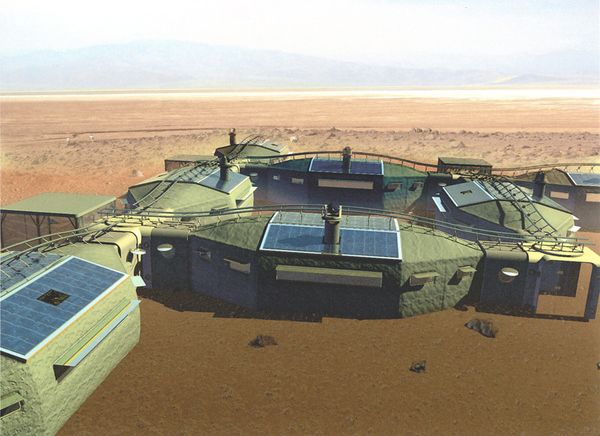
Would you like to see Mars on Earth? Then check out this innovative architectural design by Adam Ugolnik for the Mars Base Habitat. This is a modular habitat designed for Mars colony under a project for Northrop Grumman Corporation. After an intensive research on current technologies and in collaboration with the engineering expert Peter Barnett, Adam co-designed these modular units for the Mars base camp. This spacecraft design aimed at meeting the Mars habitat mission of Northrop Grumman. The corporation’s year 2005 project proposal was called Crew Exploration Vehicle, which was later renamed as Orion. A model view of the design illustrations may be observed in the above picture where it shows the connection adapters and pods that are flexible enough to support the colony’s growth in an easy manner. These act as additional land for the mission.
The Mars Base Habitat also has courtyards formed throughout the structure. During the times when there are dust storms or wild winds, these courtyards would be able to shield and protect the storage materials or supplies. While the crew remains inside the structure, it is simultaneously able to perform several activities outside the structure. This is possible with the help of a robot that can remotely support some simple tasks like the cleaning of solar arrays and security cameras. Via the roof rail-track across pods, this robot can also transport materials to long distances. The modular habitat includes dust vacuum entrance ways and screened-in porches that support the crew before entering the structure by providing a room that is moderately protected while the crew dusts off or unloads materials.
The project initially focused on fitting the entire modular structure on a flatbed truck, as well as within a cargo bay of the spacecraft that was proposed. After exploring several possible options, the finalized design was a hexagonal structure that was rover-deployed and required to be installed on the surface of the planet. A proper orientation was needed to be done by the crew using remote or manned rovers. The final modules include customizable center pillars per location needs. These modules could act as offices, ventilation spaces or living places within the camp. In order to provide extra protection and longer shelf life to the camp, a polymer spray could be used to stiffen the structural walls, based on the cargo space and needs of the environment. Thus the complete structure is quite flexible and adaptable while being easily transportable to just any place.

